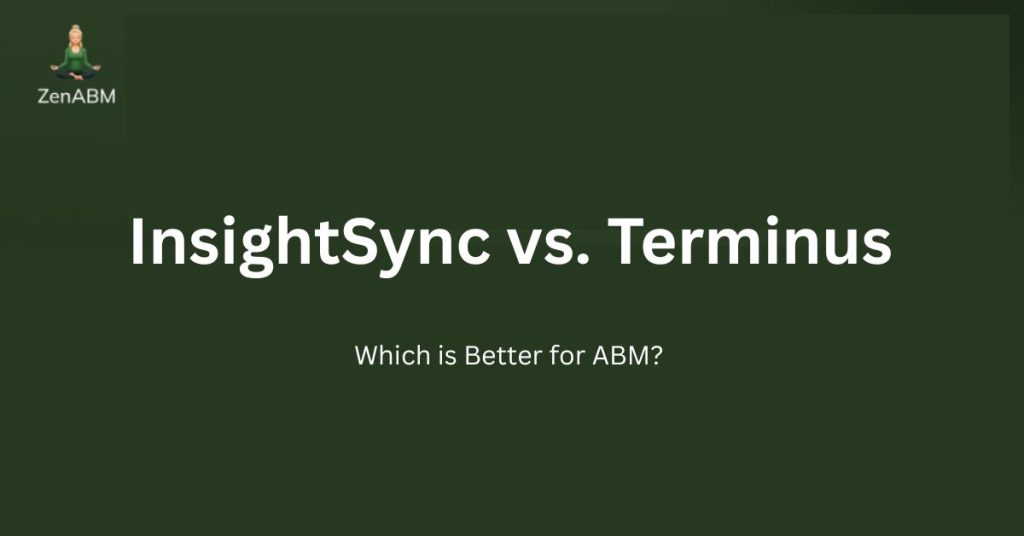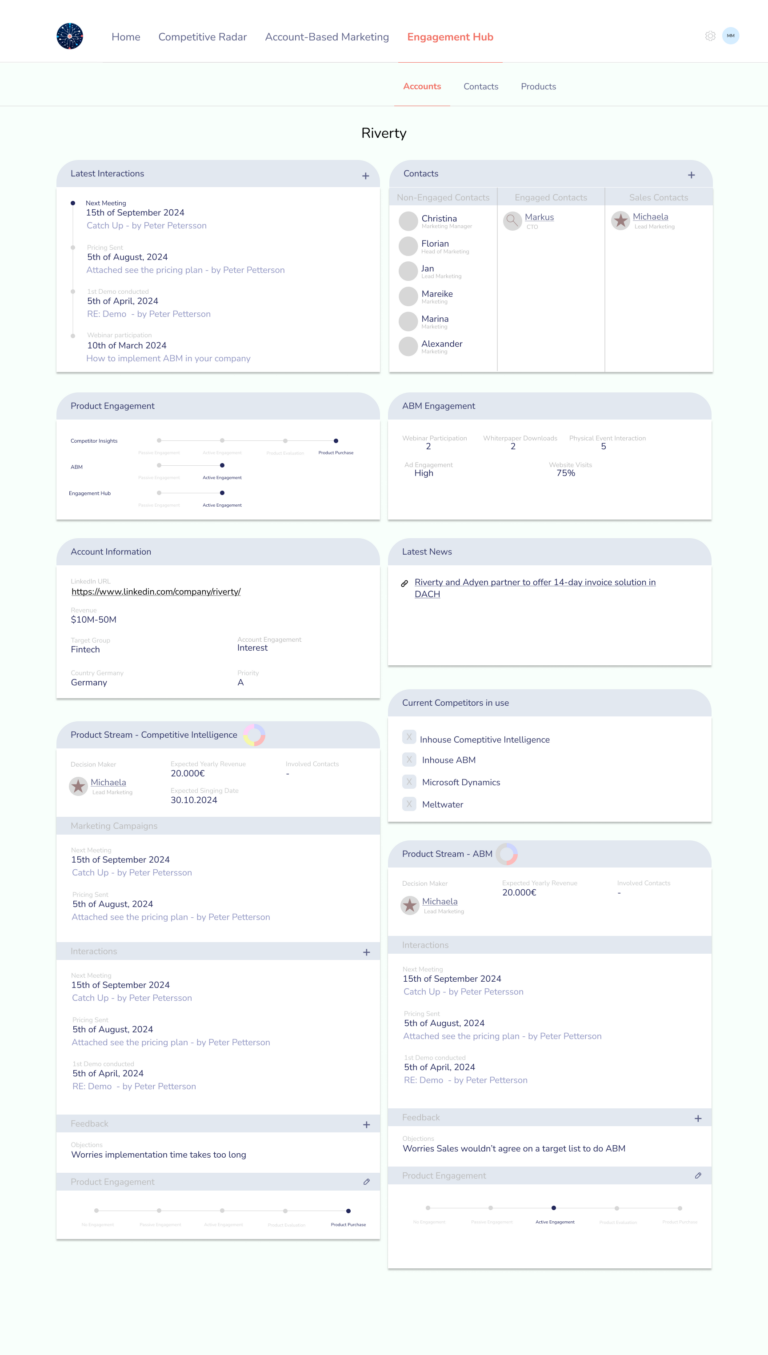InsightSync is a competitive intelligence plus ABM analytics platform, while Terminus is a full-fledged enterprise ABM suite.
In this article, I have compared InsightSync vs. Terminus on features, pricing, reviews and best fit so you can pick what works for your account-based marketing setup.
I have also explained how ZenABM can be a lean, affordable alternative or a complementary layer to these ABM tools due to its unique features.

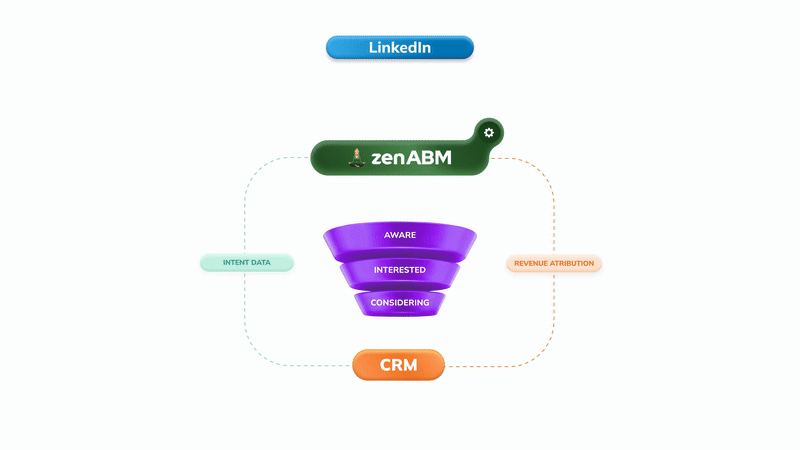
InsightSync vs. Terminus: Quick Summary
In case you want it short:
- InsightSync is a competitive intelligence plus ABM analytics platform that centralizes target accounts, engagement and competitor research for GTM teams.
- Terminus is an end to end ABM suite with its own ad network, multi channel orchestration and strong attribution and reporting.
- InsightSync works best as a CI plus ABM backbone while you keep running campaigns in tools like LinkedIn, HubSpot and your MAP.
- Terminus suits larger teams that want to run display, LinkedIn and other channels from one place and are ready for mid to high five figure or six figure contracts.
- InsightSync pricing starts around €699 per month and typically lands in the premium mid market band. Terminus commonly sits in the tens of thousands of dollars per year and can go well above that for enterprises.
- A third alternative: ZenABM offers account-level LinkedIn engagement, plug-and-play pipeline dashboards, account scoring, ABM stages, CRM sync, first-party intent, automated BDR routing, custom webhooks, an AI chatbot and job title analytics from $59 per month.
InsightSync Overview: Key Features, Pricing and Reviews
InsightSync is a newer ABM and competitive intelligence platform that pulls target accounts, engagement and competitor research into one shared system.
The promise is simple: tighter GTM alignment without adding another media buying tool.
Key Features of InsightSync
InsightSync combines three main modules in one ABM platform.
1. Competitive Intelligence Hub
This is InsightSync’s main edge over ABM-only tools.
The Competitive Intelligence Hub tracks competitors and market moves in one place.
Unified News Feed

InsightSync aggregates competitor content from news sites, press releases and internal or external blogs into one feed so you are not juggling scattered alerts.
You can tag items by competitor or topic, react, share with colleagues and set alerts for chosen tags or keywords, such as when a rival announces a new funding round or acquisition.
Competitor Radar & Profiling

The CI Hub stores structured profiles for each competitor, including logos, partners, alliances, pricing notes and positioning, so everyone works from the same reference.
AI Document Search
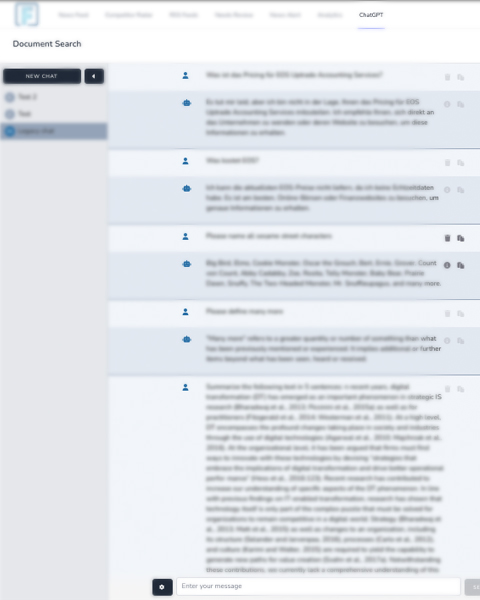
InsightSync ingests PDFs, whitepapers and internal decks and lets you query or summarize them through AI search.
2. Account-Based Marketing Hub in InsightSync
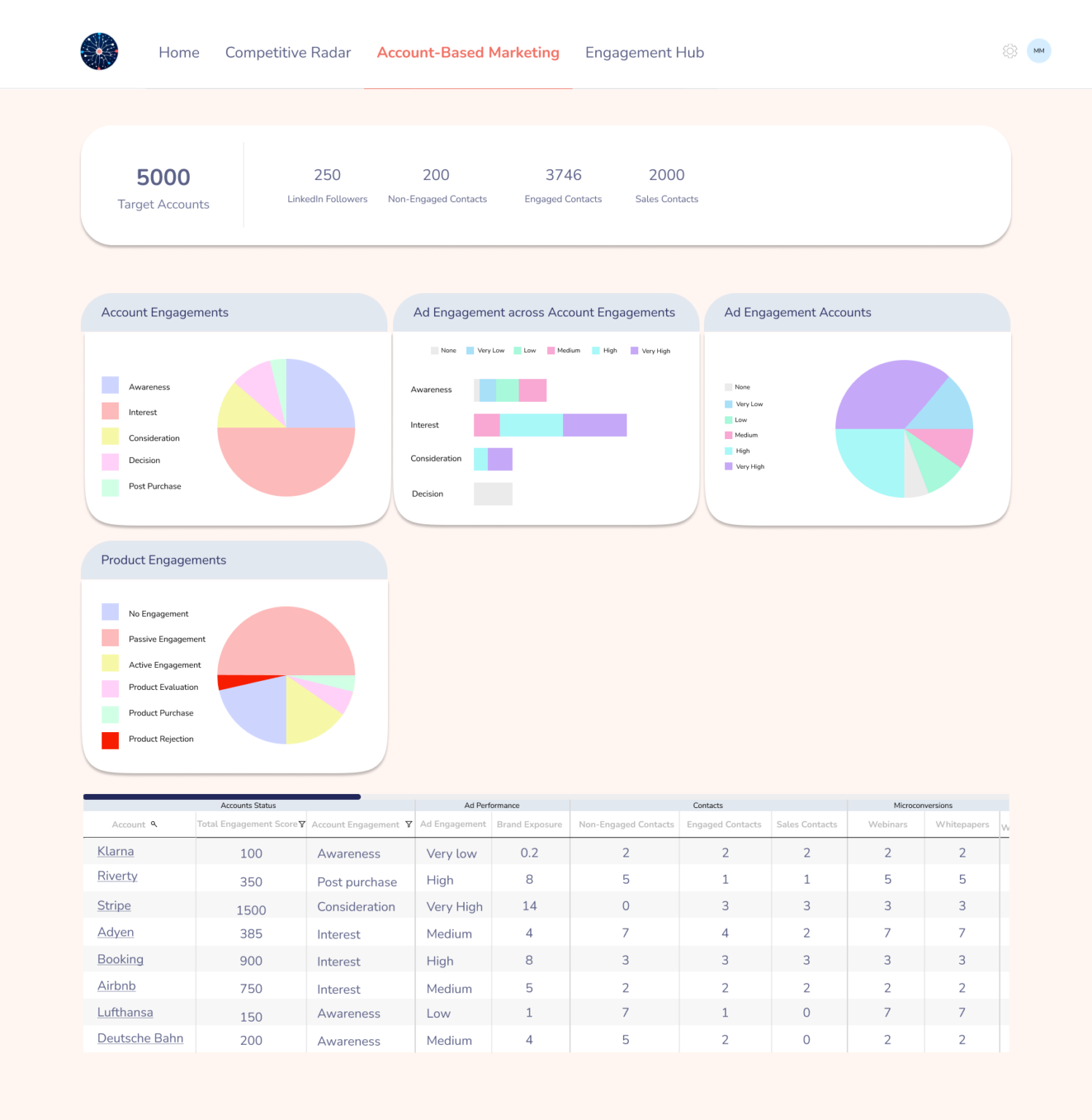
The ABM Hub revolves around three questions:
- Who are we targeting?
- What do we know about them?
- How are we engaging them right now?
It becomes the home for your account-based marketing workflows.
Target Account List Management
You can import or build target account lists from your CRM or CSV files.
Each account becomes a record you enrich over time with firmographics such as industry, size and tech stack.
Multi-channel Engagement Tracking
Once your TAL is set, InsightSync tracks engagement from ads, email and meetings in a single timeline.
You can weight actions so high intent steps like demo requests outrank casual newsletter opens and high scoring accounts bubble up as sales ready.
Real-Time Alerts & Optimization
InsightSync flags accounts that heat up or cool down so teams double down where momentum grows and step in when important accounts go quiet.
Account level views also support shifting budget to active segments and adjusting messaging where engagement lags.
Scalability & Workflow Automation
InsightSync is positioned to grow with ABM maturity and references automated outreach workflows, though public details are still limited.
Important context: InsightSync’s ABM Hub is channel agnostic and analytics-focused. It is not an ad network or full marketing automation tool like Demandbase or RollWorks. You still run campaigns in LinkedIn, HubSpot and other systems while InsightSync ingests data for reporting and attribution.
For LinkedIn-heavy teams, ZenABM connects directly to the LinkedIn Ads API.
It pulls company-level impressions, clicks, engagement and spend, scores accounts, syncs this data into the CRM as company properties and routes hot accounts to BDRs automatically.




ZenABM then ties ad engaged accounts to CRM deals and provides revenue dashboards so you can measure LinkedIn ABM impact on pipeline and revenue.

3. Engagement Hub
InsightSync’s Engagement Hub consolidates account activity such as web visits, ad clicks, email opens and event attendance across contacts.
It surfaces trends like rising interest or sudden silence, so teams prioritize active accounts and re-engage those going quiet.
At the contact level, you can see who viewed pricing, who registered but skipped webinars and who stays engaged, helping sales refine outreach and marketers improve content.

These patterns help you map buyer roles and intent, estimate funnel stage and trigger timely follow-ups.
The Engagement Hub does not execute campaigns. Its role is to keep marketing and sales aligned on account engagement and behavior.
InsightSync Pricing: How Much Does It Cost?
InsightSync targets teams that want a combined ABM and CI backbone and is priced in the premium band.
Here is the pricing as of late 2025:

- Self Service – €699/month: All three hubs with unlimited users. You manage setup and connect data manually or via the HubSpot integration, currently the only native CRM. Includes a 30-day free trial.
- Pro – €899/month (+ €3,500 one-time setup fee): Adds onboarding services. The team connects data, configures alerts and dashboards and runs an initial competitor and partner research project plus quarterly reviews.
- Custom – Contact for pricing: For Salesforce, Microsoft Dynamics, Zoho or Pipedrive users. These plans add bespoke CRM work, consulting, feature priority and support.
InsightSync is cheaper than big ABM suites, but still a mid-market to upper mid-market spend. It works best when you treat it as a CI system, ABM analytics layer and light CRM adjunct combined.
Earlier stage or lean teams may find the roughly €8K per year entry point heavy.
By comparison, ZenABM starts at about $59 per month for its starter plan.
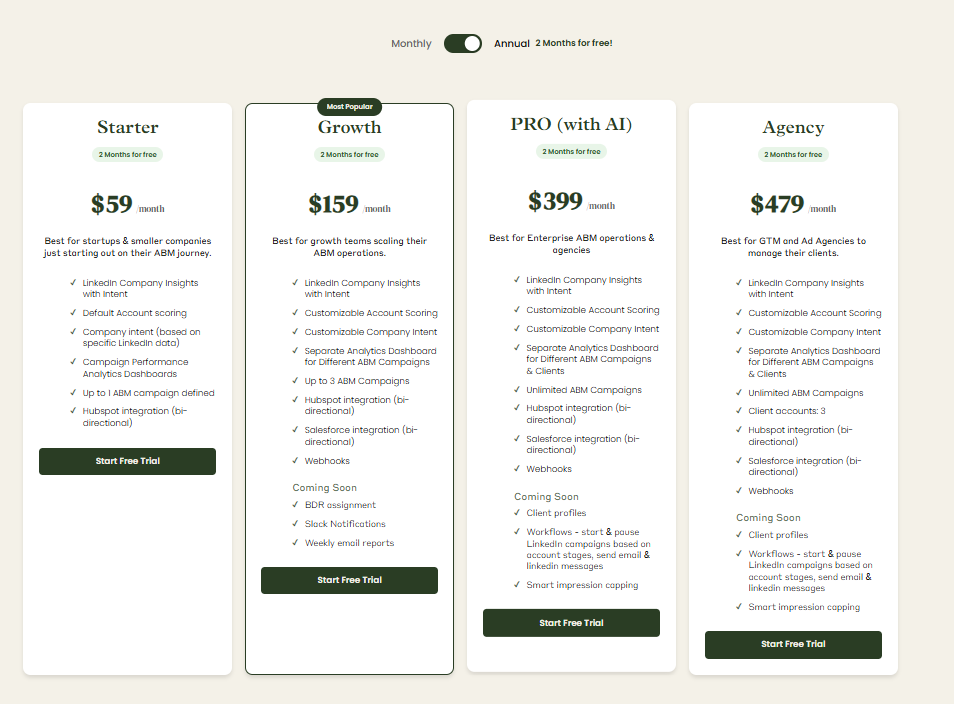
User Impressions and Reviews
Public feedback on InsightSync is still light, but some themes show up:
- Built by practitioners: InsightSync began as an internal tool from a B2B marketing lead at Riverty. ZenABM has a similar story: Michael Jackowski built it for Emilia Korczynska at Userpilot to fix LinkedIn ABM reporting before turning it into a dedicated LinkedIn ABM SaaS. Customers like Productive and Spear Growth report strong outcomes with ZenABM.

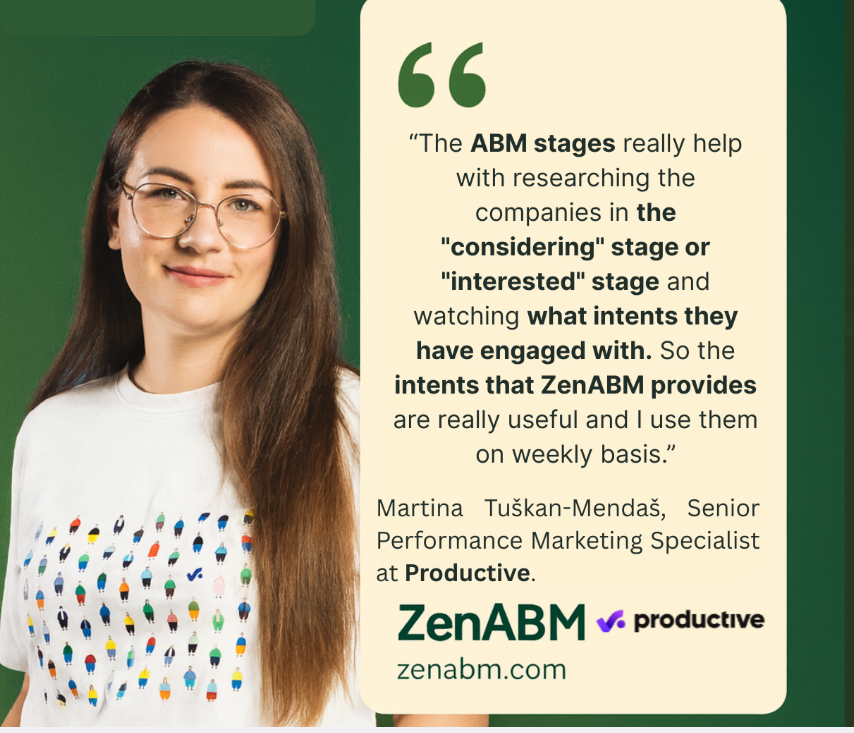
- Website testimonial: A Riverty testimonial claims InsightSync has aligned marketing and sales and that the CI Hub alone saves hours each week.
- No major review sites yet: As of November 2025, InsightSync still does not appear on G2 or TrustRadius.
Terminus Overview: Key Features, Pricing, and Reviews
Terminus is often described as an end-to-end ABM platform.
It gained prominence for its breadth of features and integrations, appealing to B2B marketers who want a unified ABM “Engagement Hub” covering advertising, web, and sales touchpoints.
Let’s have a look at its key features:
Multi-Channel Ad Support

Terminus allows you to run and manage ads across a wide range of channels natively.
This includes traditional display ads (across thousands of websites via an account-based DSP), retargeting ads, LinkedIn Ads, and even newer formats like connected TV and audio ads.
By consolidating ad channels, Terminus helps you reach target accounts on the web, social (LinkedIn), and other avenues from one platform.
It also inherently balances impressions across your target account list so that no single account consumes your entire budget.
For organizations seeking centralized ad management across channels, Terminus may be the right tool to streamline multi-channel orchestration and support your GTM strategy.
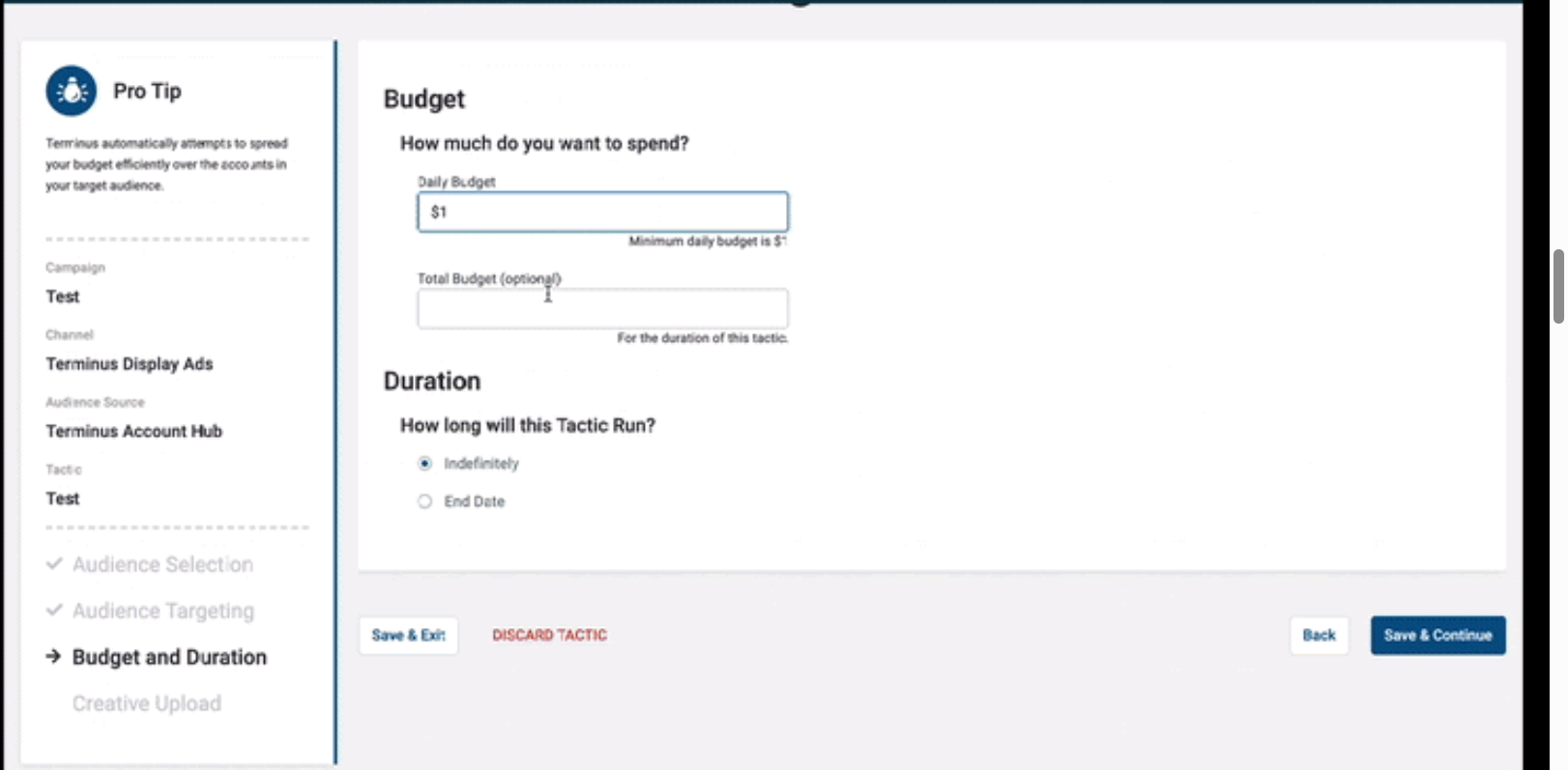
Account & Persona Targeting

You can upload or sync target account lists (TALs) from your CRM into Terminus and refine audiences by persona attributes like department, seniority, or role.
Account-Level Engagement Tracking
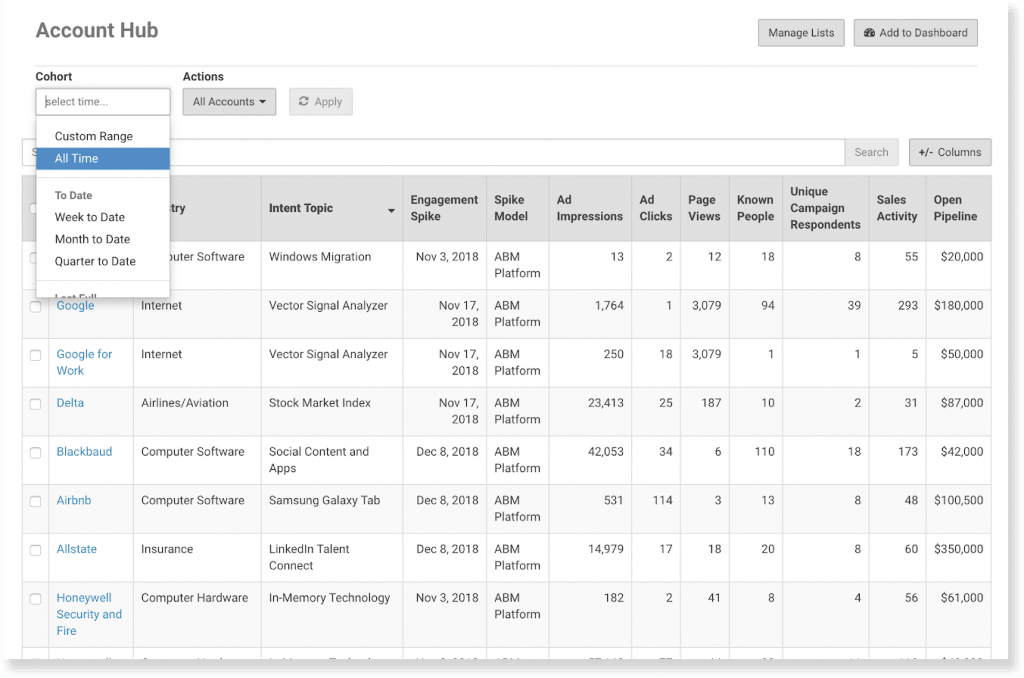
The platform tracks not just clicks but also impressions at the account level.
This is critical in ABM, where seeing that target account X saw an ad (even without clicking) is valuable. Terminus’s Account Hub compiles these engagement metrics for each account, showing impressions, clicks, site visits, and more tied to your campaigns. These engagement metrics also support more accurate marketing attribution for ABM campaigns, helping you analyze the impact of each touchpoint across the buyer journey.
Website Visitor Identification
Terminus includes a Visitor ID feature to de-anonymize website traffic.
It uses techniques like reverse IP lookup, cookies, and CRM matching to recognize which companies (and sometimes which known contacts) are visiting your site.
For instance, Terminus can drop cookies so that if an anonymous visitor later fills out a form, their past visits are attributed to that account.
It also matches known CRM leads to visits (by email domain), telling you if, say, a director from Acme Corp in your CRM visited the pricing page.
Intent Data
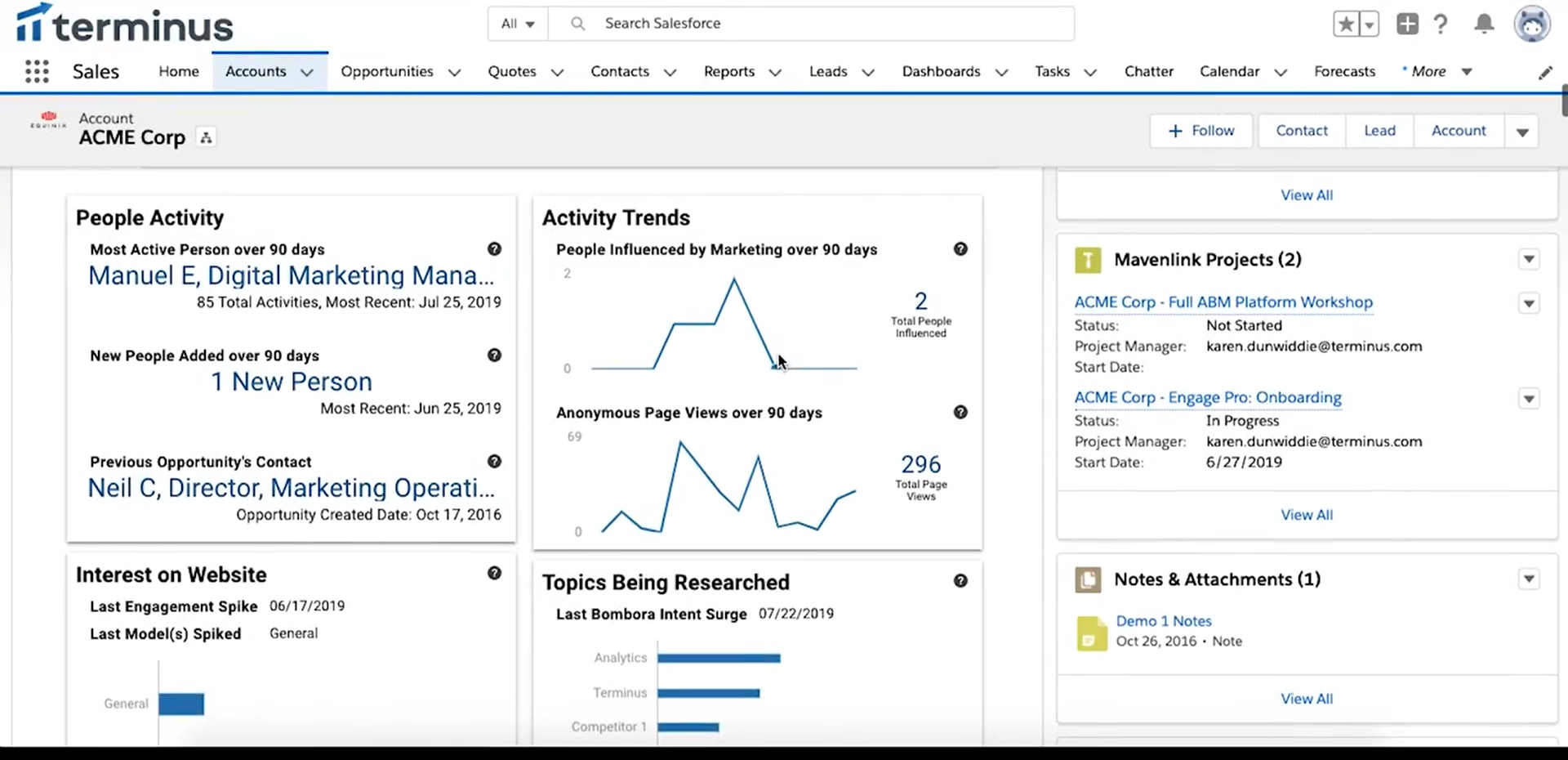
Terminus integrates intent data from partners (e.g., Bombora) to identify in-market accounts, so you can prioritize ad spend on companies showing buying signals.
Pro Tip: Skip unreliable third-party intent surges and focus on first-party insights instead.
ZenABM captures authentic, first-party qualitative intent by tracking which LinkedIn ads a company actually engages with, offering clear, actionable buying signals.

For example, the team at Userpilot (a ZenABM customer) built their ABM playbooks entirely around this method, tagging campaigns by pain points and doubling down on bottom-of-funnel ads that specific accounts were interacting with.
Their campaign structure looked like this:

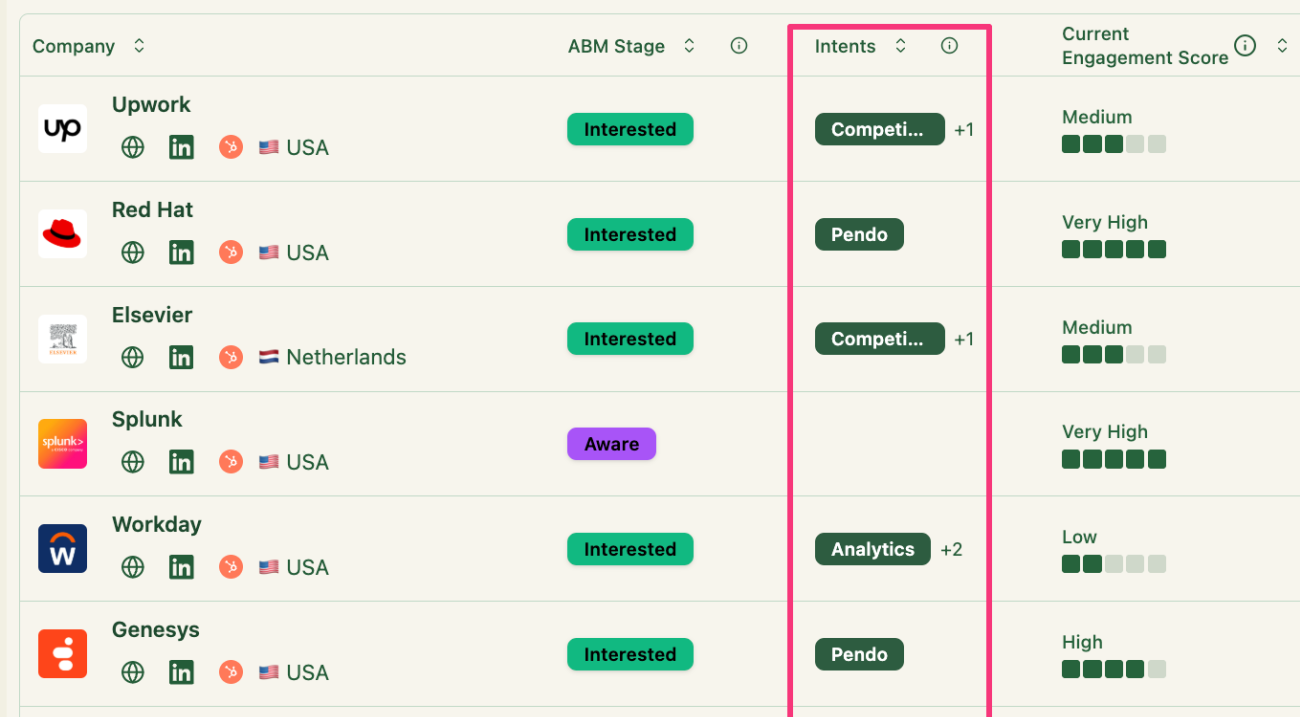
ABM Analytics and Attribution
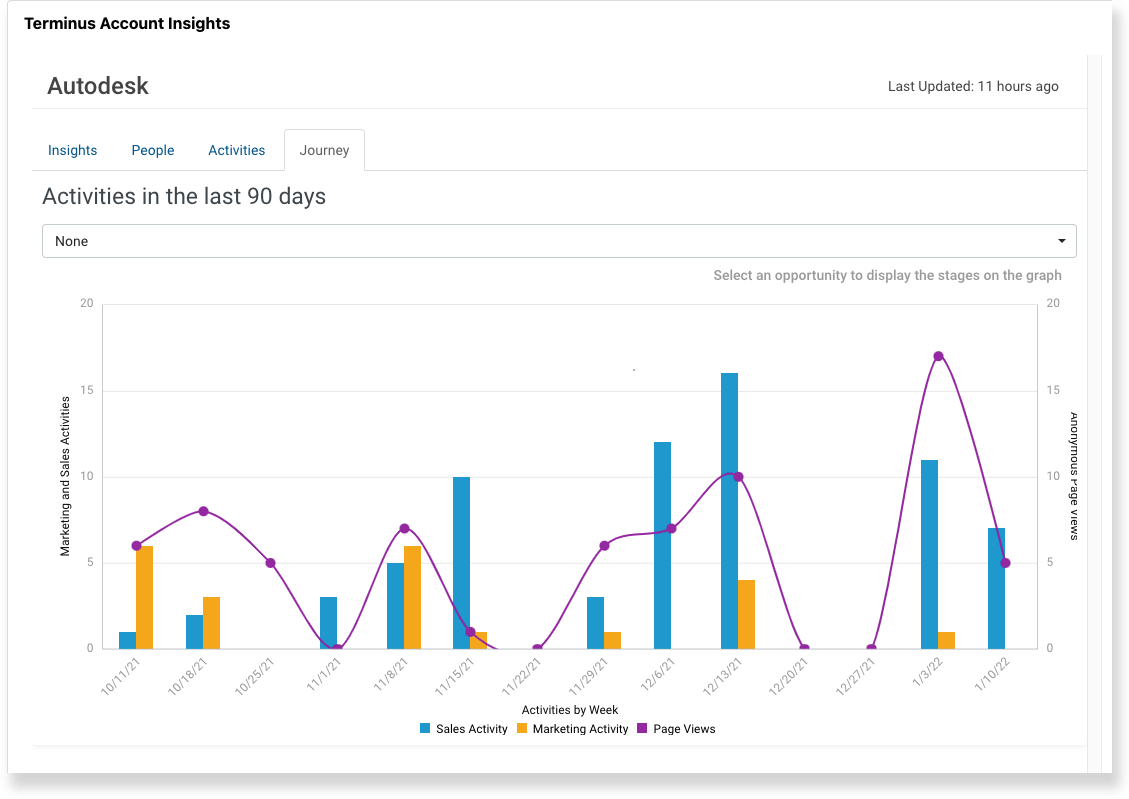
Measurement Studio in Terminus (bolstered by Terminus’s acquisition of BrightFunnel) provides multi-touch attribution across accounts.
Marketers can track how different touchpoints (ads, emails, website visits, events, etc.) influence pipeline and revenue, with support for first-touch, last-touch, and custom multi-touch models.
Importantly, all attribution is account-centric by default: activities roll up into an “Account Journey” view to see how an account progressed from engagement to pipeline to deal.
Terminus also offers out-of-the-box dashboards for ABM programs, showing metrics like revenue generated, opportunities created, pipeline influenced, top engaged accounts, and more. Marketers can also track engagement with related topics to identify new opportunities.
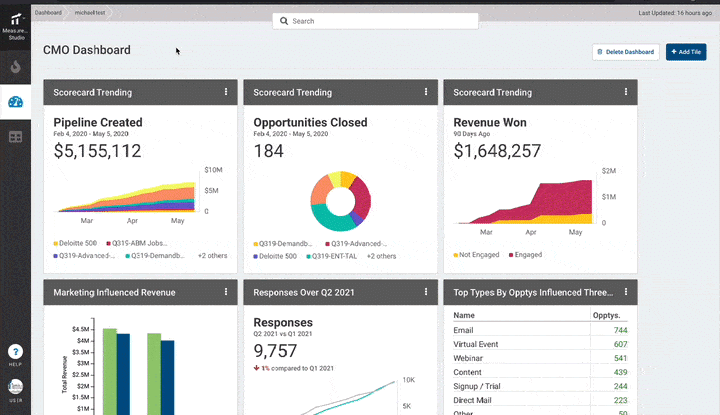

Integrations
Terminus integrates with many systems in the B2B marketing stack.
Out-of-the-box connectors include major CRMs (Salesforce, HubSpot, Microsoft Dynamics), marketing automation platforms (Marketo, Pardot, HubSpot Marketing Hub, Eloqua), advertising channels (LinkedIn Ads, Google Ads), sales enablement tools (Outreach, Salesloft, etc.), analytics tools (Google Analytics, Adobe Analytics, PathFactory), data providers (Bombora, G2 intent, Clearbit/DemandScience), and more.
You can explore each integration in detail in the Terminus docs.
Terminus Pricing
Terminus is known for its premium, custom-quoted pricing.
There are no public price tiers on their site; you need to go through sales for a quote.
Research indicates typical Terminus deals are in the mid-five figures annually, scaling up to six figures for large enterprise deployments.
Vendr, for example, says median Terminus pricing is about $23,000 per year, while large enterprises might pay $100K–250K+ annually.
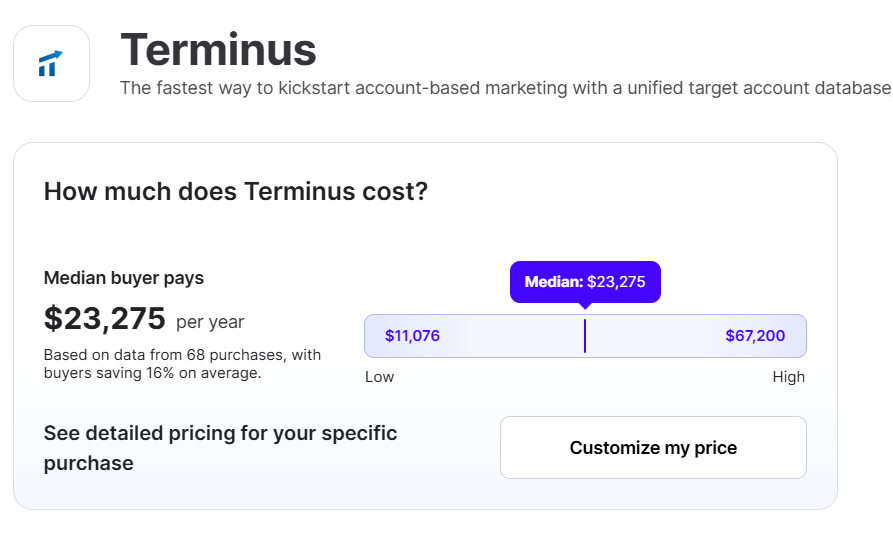
CMO.com, on the other hand, claims the cost to start from $57,500 per year, with large enterprise contracts reaching $266,000, and G2 (based on 17 reviews) gives a broad range of $18-87,000. This pricing structure is not suitable for small businesses with limited budgets.
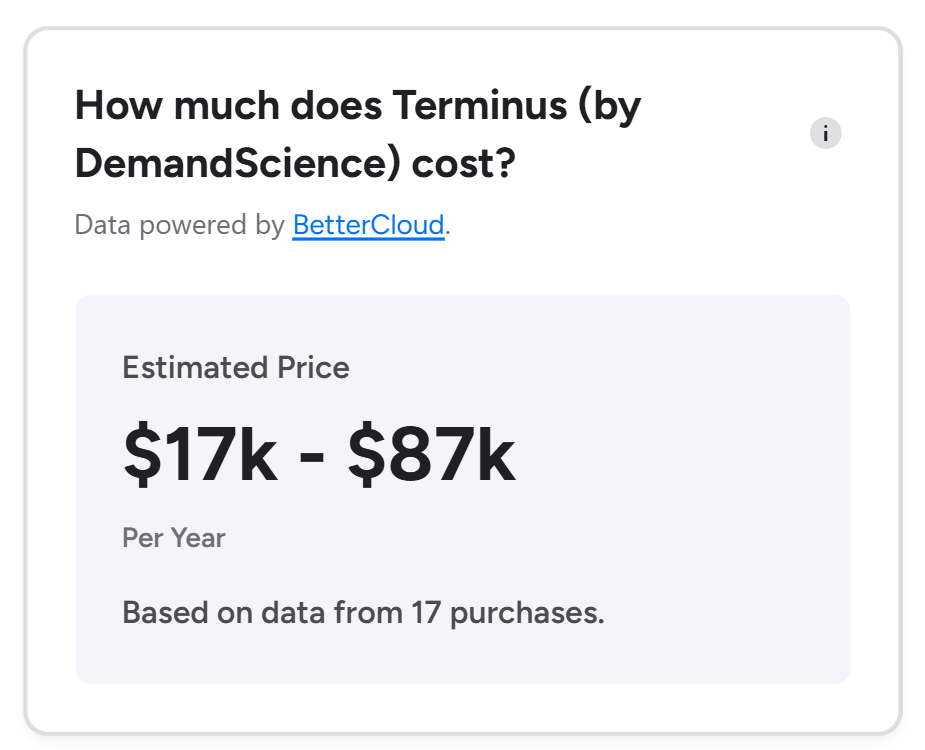
Terminus Reviews
Users on platforms like Trustradius, Infotech.com, Software Finder, etc., have praised Terminus for its good UX and end-to-end ABM features but have complained about high cost, restricted number of accounts per campaign, limited reporting features, and some integration issues with HubSpot.
InsightSync vs. Terminus: Key Differences
Here is a direct tabulated comparison of InsightSync and Terminus across their core features and positioning.
| Feature category | InsightSync | Terminus |
|---|---|---|
| Core positioning | Competitive intelligence plus ABM analytics layer for target accounts and competitors | End to end ABM suite with advertising, visitor ID, intent and attribution |
| Primary focus | Give GTM teams a shared view of who to target, how they engage and what competitors are doing | Run and coordinate multi channel campaigns for target accounts and connect them to pipeline |
| Main modules | Competitive Intelligence Hub, ABM Hub, Engagement Hub | Account and persona targeting, multi channel ads, visitor ID, intent, Measurement Studio |
| Channels covered | Channel agnostic analytics that ingest data from LinkedIn, email, meetings, web and other tools | Display and retargeting, LinkedIn, CTV and audio plus support for email and sales touchpoints |
| Execution capabilities | Does not buy media, focuses on analytics, scoring, alerts and competitive intelligence | Runs ads natively across channels and balances impressions across the target account list |
| Intent model | Account level engagement from your own channels plus competitor content and profiles | Uses partner intent data and engagement to find in market accounts and prioritize spend |
| Website capabilities | No native web personalization, insights can inform changes in other systems | Visitor identification and account level web analytics to support ABM programs |
| CRM and MAP integrations | Native HubSpot integration and custom work for Salesforce, Dynamics, Zoho and Pipedrive | Integrates with Salesforce, HubSpot, Dynamics, major MAPs and sales engagement tools |
| Analytics and attribution | Account level engagement views and CI reporting to align marketing and sales | Measurement Studio with multi touch attribution, account journeys and ABM dashboards |
| Pricing profile | Premium euro priced platform starting around €699 per month plus setup fees on some tiers | Custom enterprise pricing, often from tens of thousands to six figures per year depending on scope |
| Review footprint | Early website testimonials and practitioner origin story, light coverage on review sites so far | Broad presence on review and analyst sites with praise for breadth and complaints about cost and limits |
| Ideal team profile | B2B teams that want one CI plus ABM analytics backbone while keeping their existing media stack | Mature ABM teams that want to centralize multi channel advertising and attribution in one platform |
| Best use case | Aligning marketing and sales on which accounts to pursue, when to act and what competitors are doing | Running scaled multi channel ABM programs and proving impact on pipeline and revenue |
| Where ZenABM fits | Acts as a LinkedIn first companion when you need precise company level ad engagement and first party intent in the CRM | Acts as a lean LinkedIn layer when you want company level engagement and attribution without a full suite |
InsightSync vs. Terminus: So, Which Is Better for ABM?
InsightSync is the better fit if your main problem is shared context, not another ad platform. It gives marketing and sales one view of target accounts, how they are engaging, and what competitors are doing, without asking you to rip out your current demand tools. If you already run campaigns in LinkedIn, HubSpot or your MAP and want tighter alignment, cleaner account timelines and a lightweight CI system on top, InsightSync is the more focused option, as long as the roughly €8K per year starting point is acceptable.
Terminus is the better fit if you want a full ABM engine that can actually run ads across channels and roll engagement back into one account view. It makes sense for teams that need programmatic ads, LinkedIn, visitor identification, intent data and account level attribution under one roof, and that have budget and operations capacity for a mid to high five figure platform.
If your real priority is to get more pipeline from LinkedIn and you do not need a heavy suite just to understand which companies saw and engaged with your ads, both tools can be more than you need for the LinkedIn slice alone.
ZenABM as a LinkedIn-First, First-Party Lean ABM Alternative
There is also a third option: ZenABM.
ZenABM is designed for teams that rely on LinkedIn as the primary ABM channel and want first-party accuracy, automation and revenue visibility without multi-channel suite pricing or an overwhelming UX.
Account-Level LinkedIn Engagement Tracking


ZenABM connects to the official LinkedIn Ads API and captures account-level data across all campaigns so you can see which companies see, click and engage with your ads.
Because this is first-party data from LinkedIn, it is more reliable than IP or cookie-based visitor identification.
A Syft study puts IP-based identification at about 42 per cent accuracy.

ZenABM treats LinkedIn ad engagement as first-party intent. When several people in one company keep engaging, that is a strong buying signal without rented intent feeds.
Real-Time Engagement Scoring + Full Touchpoint Timeline

ZenABM updates scores as accounts interact with your ads so you can see who is heating up and let marketing and sales prioritize accounts with real intent.
ZenABM also shows the full touchpoint timeline for each company:

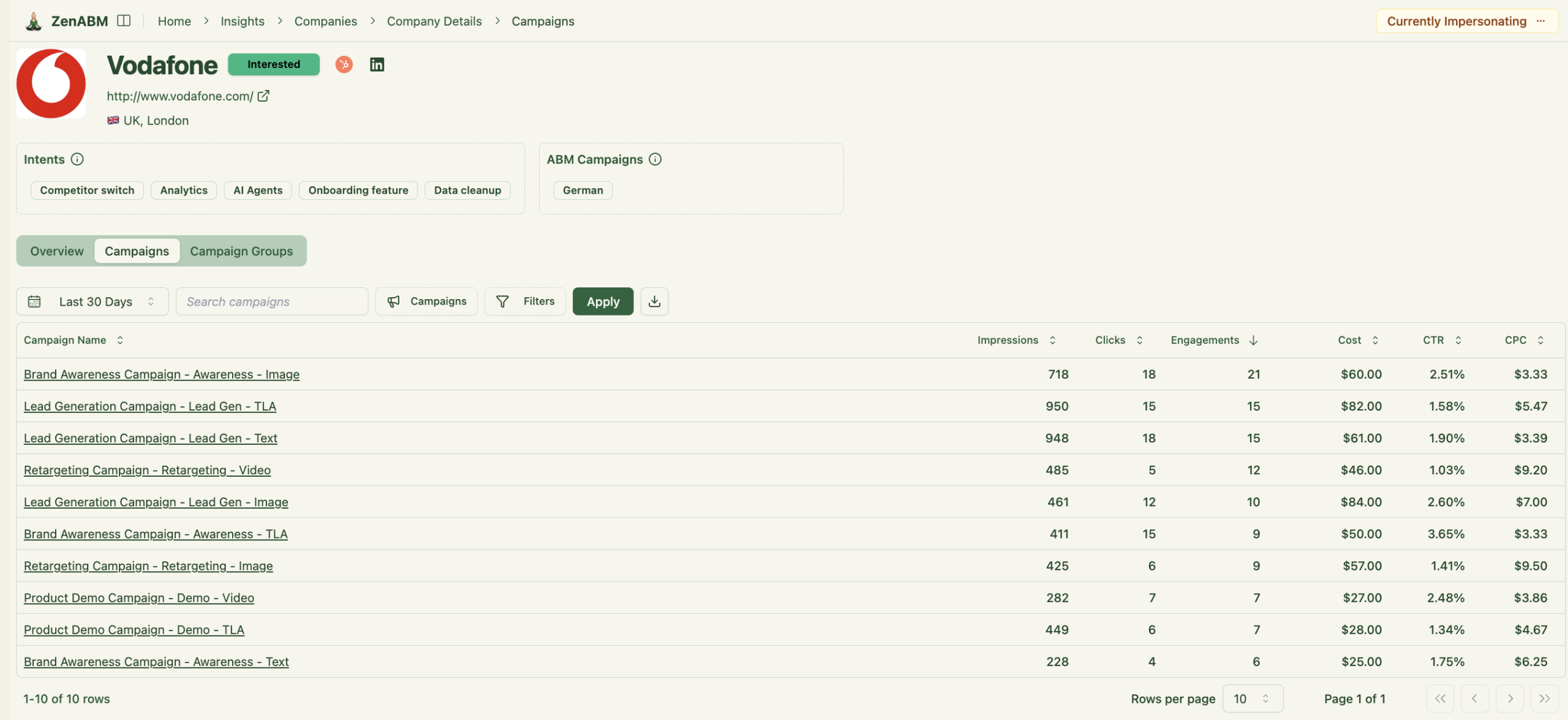
ABM Stage Tracking

ZenABM lets you define stages such as Identified, Aware, Engaged, Interested and Opportunity and automatically places accounts in the right stage using scores and CRM data.
You set thresholds, and ZenABM tracks movement over time.
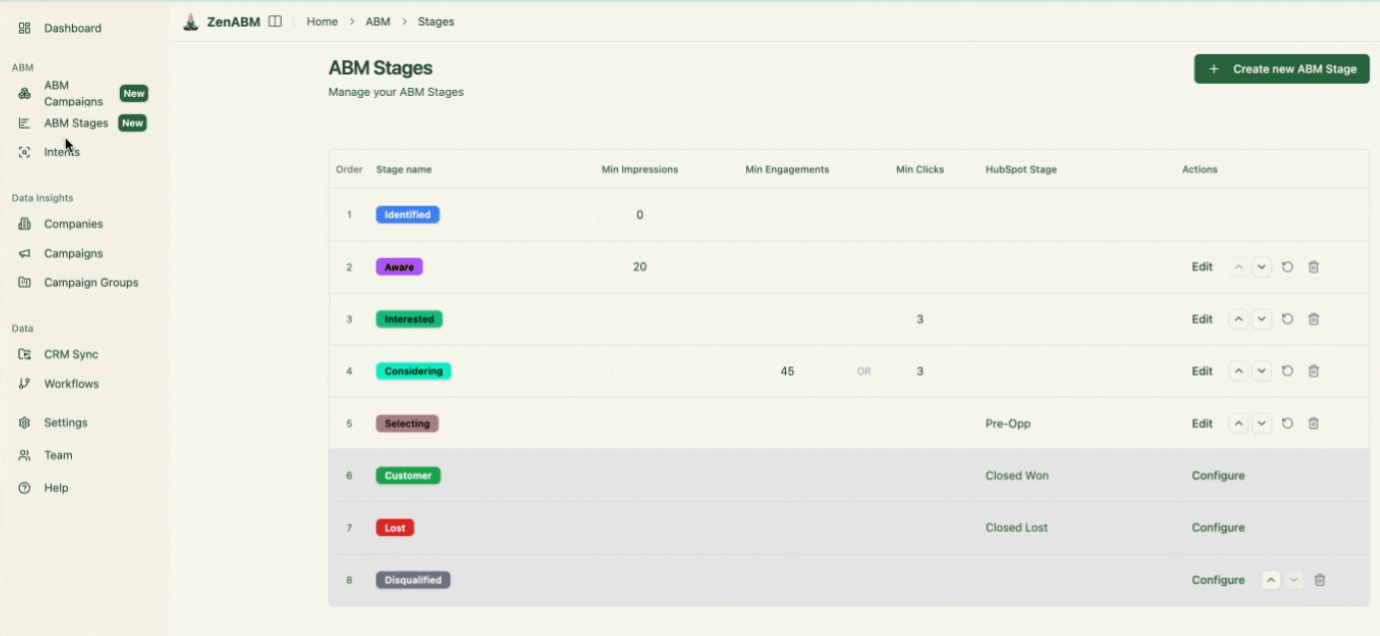

This gives you funnel visibility similar to larger suites, powered mainly by LinkedIn data.
CRM Integration and Workflows
ZenABM integrates bi-directionally with HubSpot and adds Salesforce sync on higher tiers.
LinkedIn engagement data flows into the CRM as company properties:

Once an account crosses your score threshold, ZenABM updates the stage to Interested and assigns a BDR.

Intent Tagging from Ad Engagement
ZenABM lets you derive intent topics from LinkedIn campaigns by tagging campaigns by feature, use case or offer.
ZenABM then shows which accounts respond to which themes.
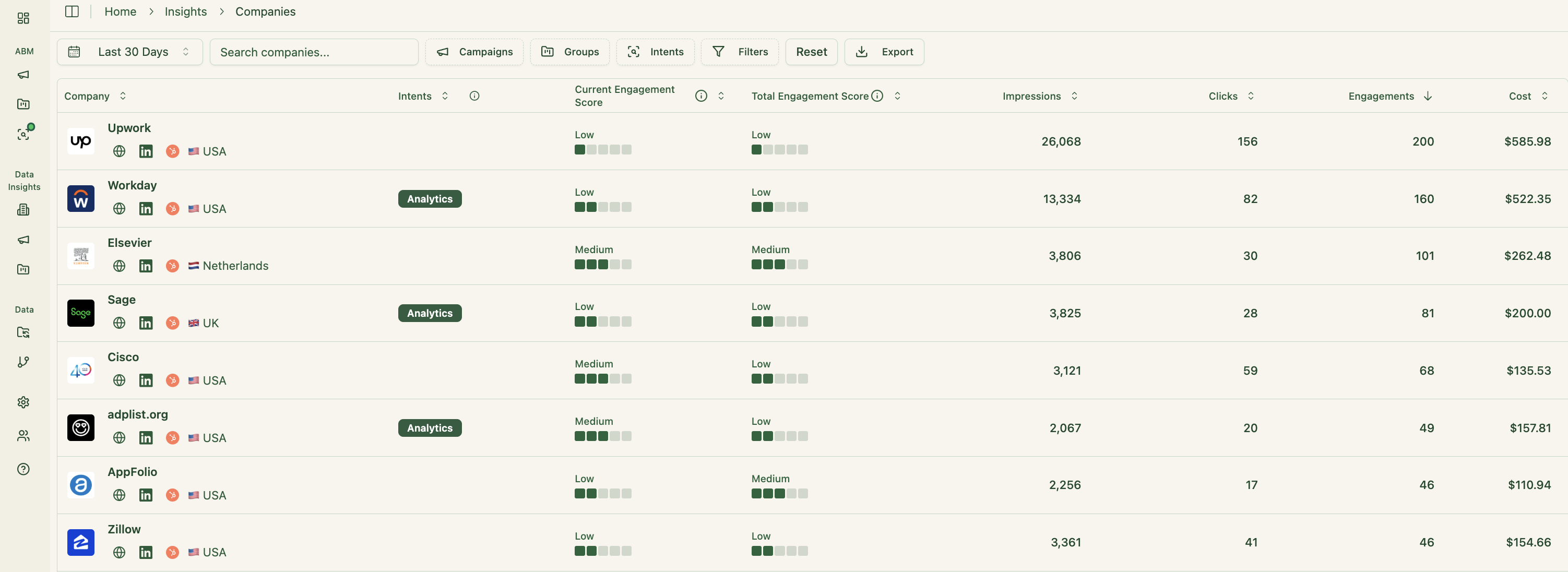
This is clean first-party intent from owned interactions.
You can push these topics into your CRM so sales and marketing can tailor outreach to what each company has explored.
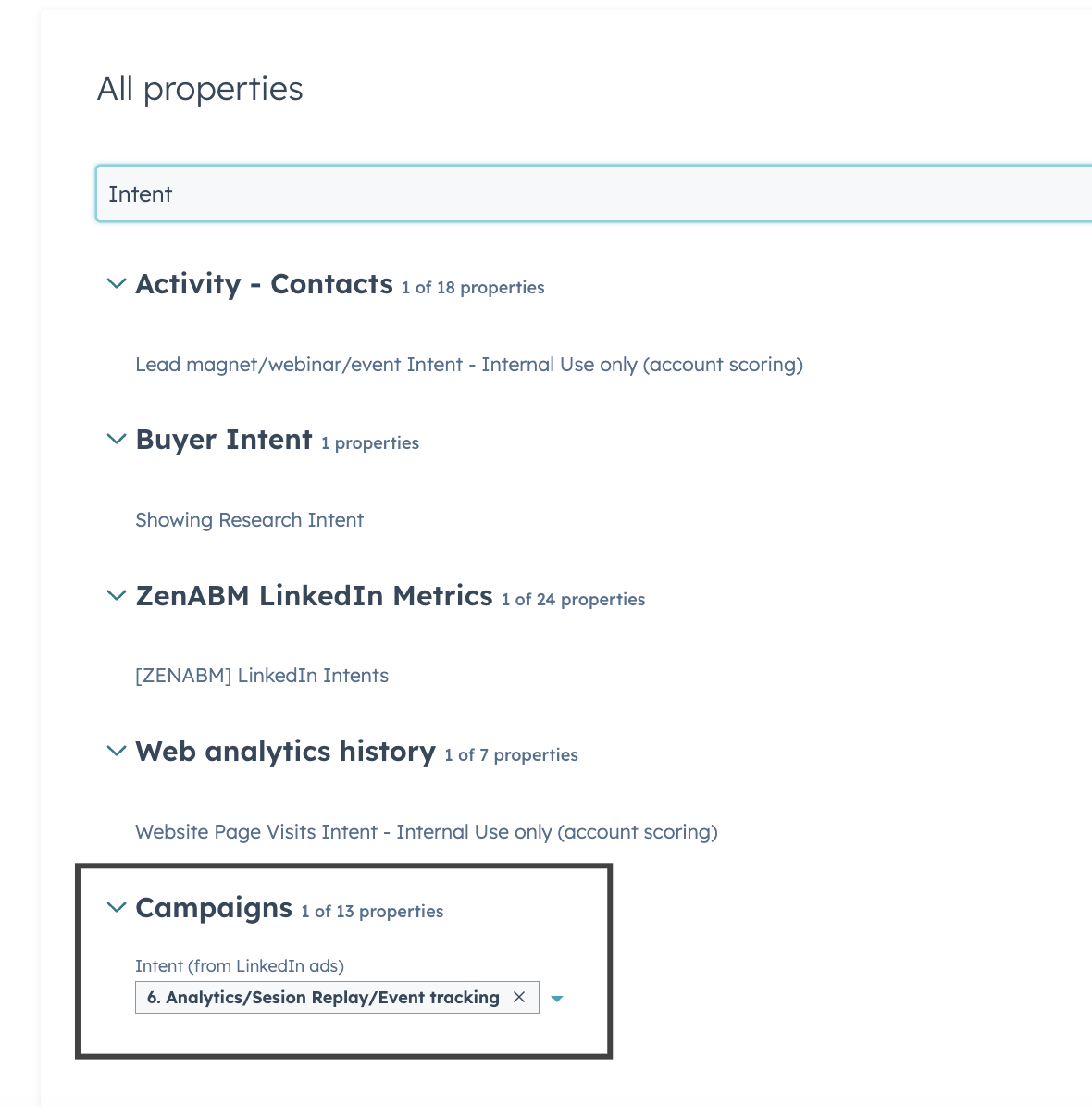
Built-in Dashboards and ABM Analytics
ZenABM ships with dashboards that connect LinkedIn ads to account engagement, stage movement and revenue.
- You can track performance from ABM campaigns down to campaign groups and individual ads:
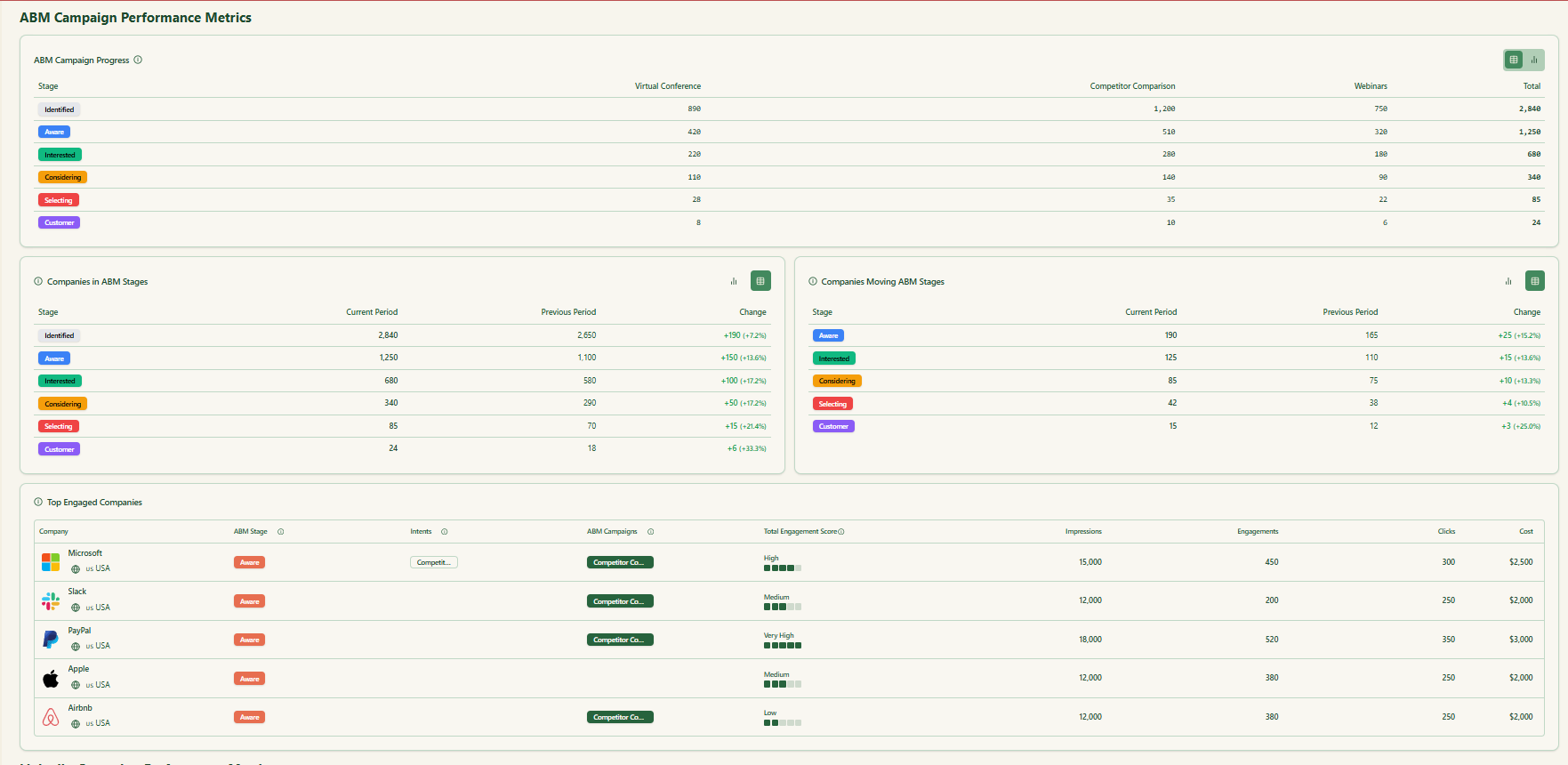

- Because ZenABM stores deal value and ad spend per company and campaign, it can calculate ROAS, pipeline per dollar and pipeline contribution.

Custom Webhooks
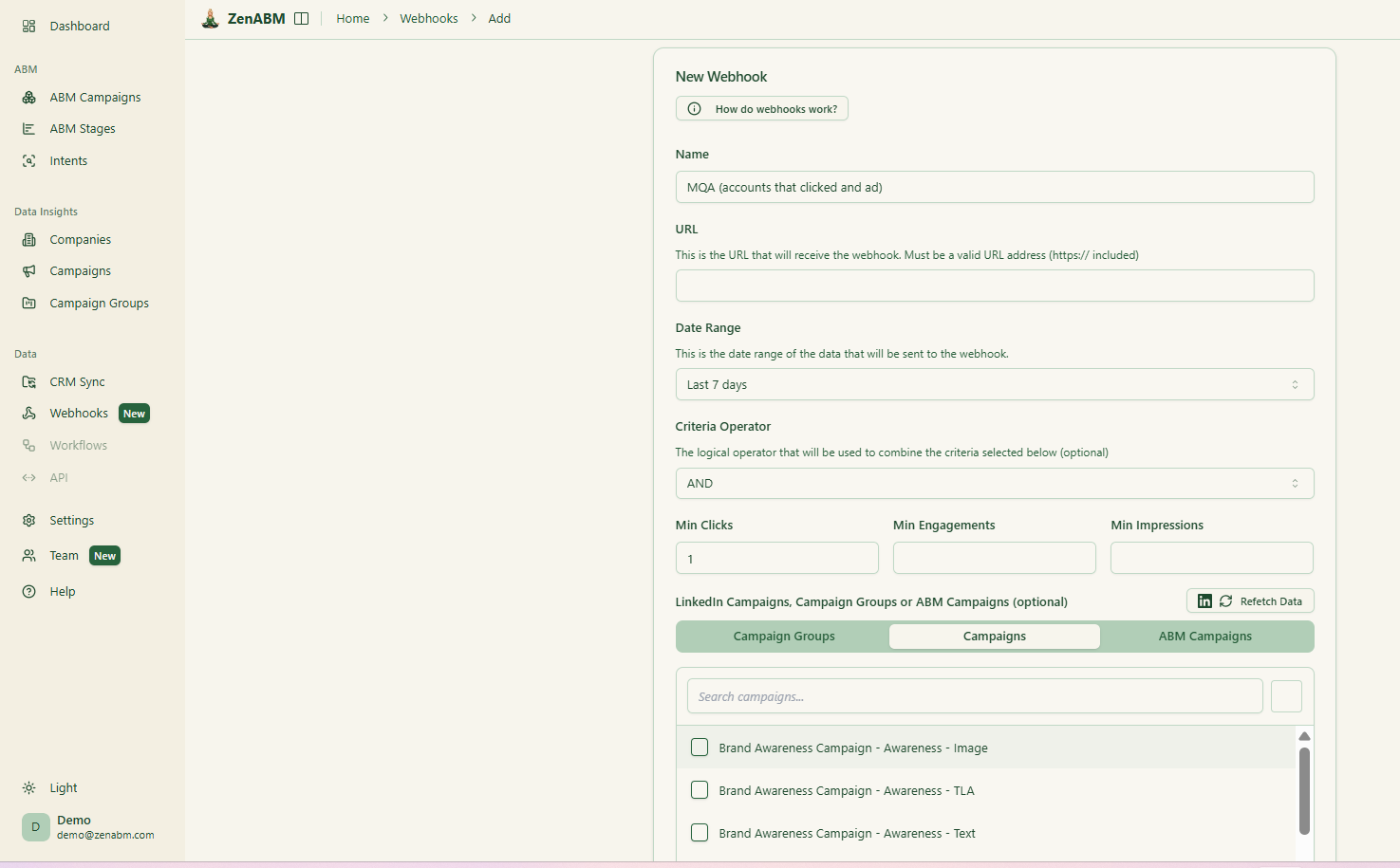
ZenABM’s webhooks let you push events into your stack, such as Slack alerts, enrichment flows or other automations.
Job-Title Analytics
ZenABM shows which job titles engage with your creatives and gives dwell time and video funnel analytics.
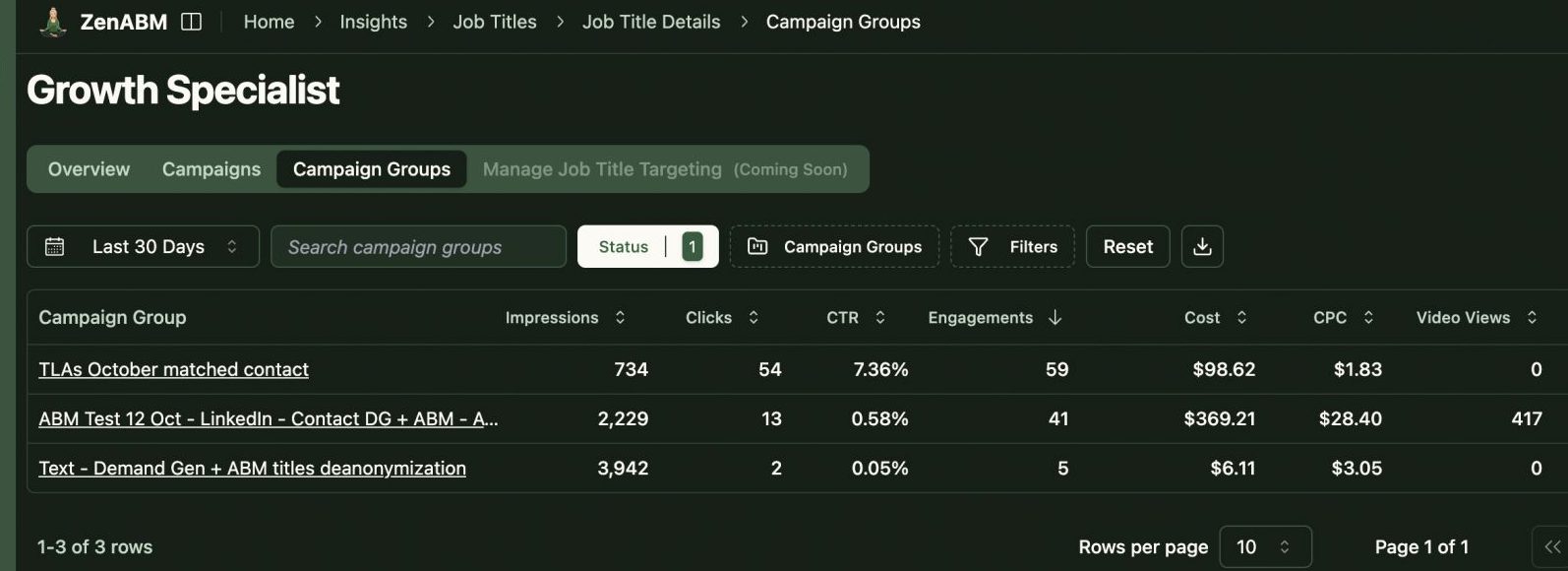
ABM Campaign Objects for True Multi-Campaign Attribution
Most tools treat each LinkedIn campaign separately. ZenABM lets you group several into one ABM campaign object so you can see performance across regions, personas or creative clusters.
Instead of juggling fragmented reports in Campaign Manager, you see spend, pipeline, account movement and ROAS for the full initiative.
AI Chatbot to Analyze Your LinkedIn and ABM Data
ZenABM includes an AI chatbot on top of your LinkedIn API data and ABM model.
You can ask questions such as “Which accounts moved from Interested to Selecting last month?” or “What is my pipeline per dollar on retargeting?” and get answers based on live data.
Multi Client Workspace for Agencies
For agencies, ZenABM offers a multi-client workspace.
You can manage multiple ad accounts and clients in one environment, each with its own ABM strategy, dashboards and reporting instead of switching accounts in Campaign Manager.
ZenABM Pricing

Plans start at $59 per month for Starter, $159 for Growth, $399 for Pro (with AI) and $479 for Agency.
The agency plan stays under $6,000 per year.
That’s far less than Terminus or InsightSync.
All tiers include core LinkedIn ABM features. Higher tiers mainly raise limits and add Salesforce sync.
Plans are offered monthly or annually, and each plan includes a 37-day free trial.
Conclusion
InsightSync is a solid choice if you want a shared, strategic view of accounts and competitors that keeps marketing and sales aligned while you keep running campaigns in LinkedIn, HubSpot and your existing MAP.
It behaves more like a CI plus ABM analytics backbone than a media platform, which suits teams that care about clarity and coordination first.
Terminus makes more sense if you are ready for a full ABM engine that can run ads across many channels, combine visitor ID and intent signals and give you multi touch attribution at the account level.
The tradeoff is higher cost and more operational overhead, which usually only pays off for teams with larger budgets and a mature ABM program.
For LinkedIn heavy ABM teams that care most about first-party accuracy, account scoring, ABM stages, CRM sync and revenue attribution, ZenABM offers a leaner route.
You get company-level LinkedIn engagement, clear intent signals, plug-and-play dashboards and automated BDR routing from $59 per month.
Try ZenABM now for free (37-day free trial) or book a demo to know more.

